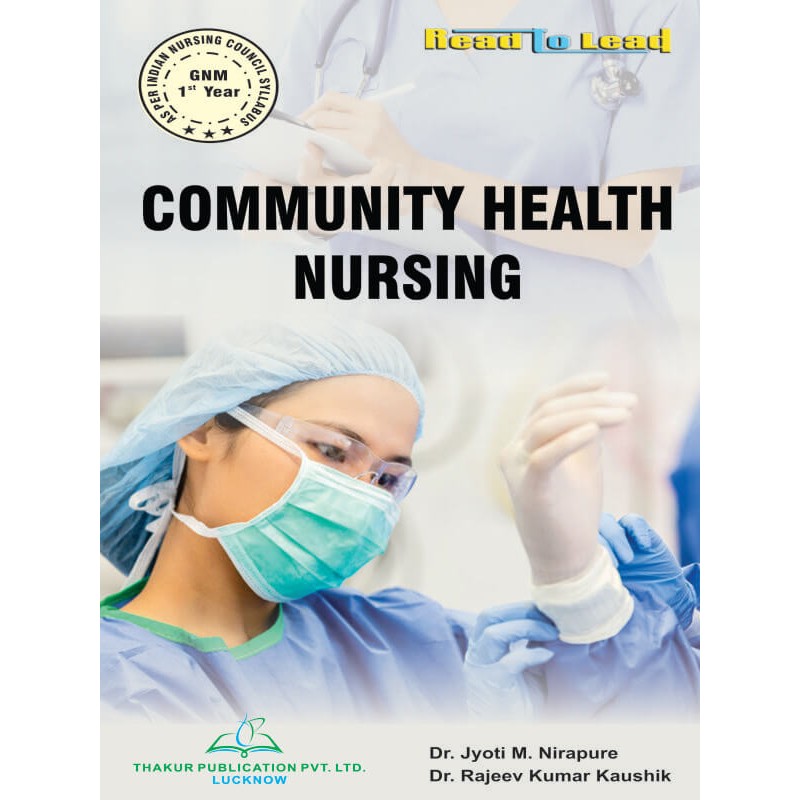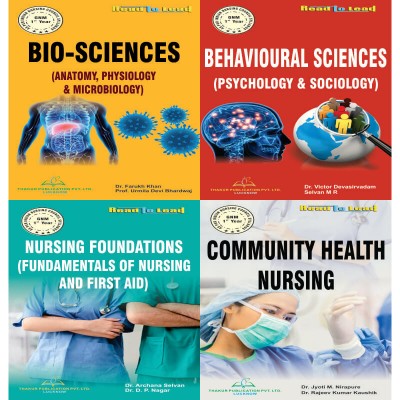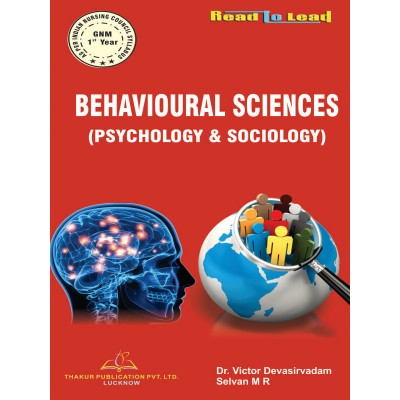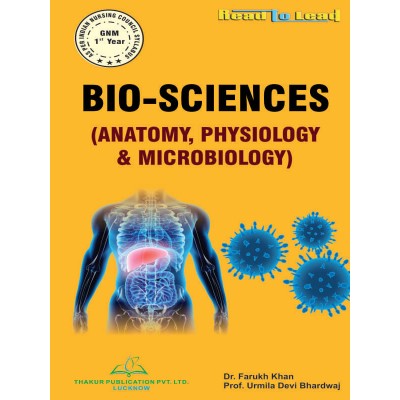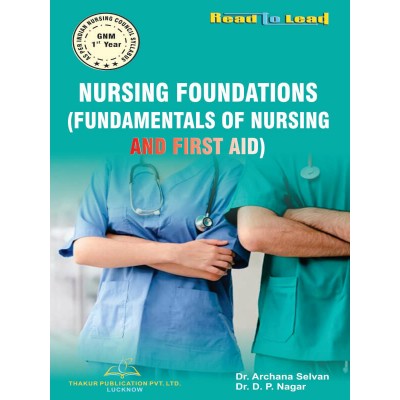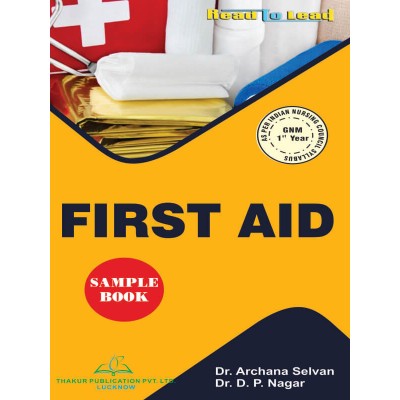Community Health Nursing-I
₹360.00
Tax excluded
Click below to Buy E-Book Edition:
We are providing Community Health Nursing-1 book for GNM 1st year in English as per INC by Thakur Publication. Community Health Nursing book covered all syllabus.
The 'Community Health Nursing' book for GNM First year is a comprehensive guide to the principles and practices of nursing in community settings. Written in English, this book covers topics such as community health assessment, epidemiology, preventive care, and health promotion. It emphasizes the role of a nurse in addressing the healthcare needs of individuals, families, and communities.
FAST & ALL INDIA DELIVERY · USER-FRIENDLY LAYOUT · COVERED COMPLETE SYLLABUS
With its practical approach, case studies, and evidence-based guidelines, this book equips GNM students with the knowledge and skills required to deliver effective and culturally sensitive healthcare in community settings.
ISBN- 978-93-90460-68-7
AUTHORS- Dr. Jyoti M. Nirapure , Dr. Rajeev Kumar Kaushik
Syllabus
1.4. (1) COMMUNITY HEALTH NURSING - I
|
Unit. No. |
Learning |
Objectives Content |
Hr. |
|
I |
Describe the concept of health and disease and community health |
Introduction to Community Health - Definitions: Community, Community Health, Community Health Nursing - Concept of Health and Disease, Dimensions and Indicators of Health, Health Determinants - History & Development of Community Health in India& its present Concept. - Primary health care, Millennium Development Goals - Promotion and maintenance of Health |
10 |
|
II |
Explain various aspects of Community Health Nursing. Demonstrate skills in applying nursing process in Community Health Nursing settings |
Community Health Nursing - Philosophy, goals, objectives & principles, Concept and importance of Community Health Nursing, - Qualities and functions of Community Health Nurse - Steps of nursing process; community identification, population composition, health and allied resources, community assessment, planning & conducting community nursing care services. |
14 |
|
III |
Demonstrate skill in assessing the health status and identify deviations from normal parameters in different age groups. |
Health Assessment a) Characteristics of a healthy individual b) Health assessment of infant, preschool, school going, adolescent, adult, antenatal woman, postnatal woman, adult and elderly. |
10 |
|
IV |
Describe the principles of epidemiology and epidemio logical methods in community health nursing practice. |
Principles of Epidemiology and Epidemiological methods - Definition and aims of epidemiology, communicable and non-communicable diseases. - Basic tools of measurement in epidemiology - Uses of epidemiology - Disease cycle - Spectrum of disease - Levels of prevention of disease. - Disease transmission – direct and indirect. - Immunizing agents, immunization and national immunization schedule. - Control of infectious diseases. - Disinfection. |
10 |
|
V |
Demonstrate skill in providing comprehensive nursing care to the family. |
Family Health Nursing Care - Family as a unit of Health - Concept, Goals, Objectives - Family Health Care Services - Family Health Care Plan and Nursing Process. - Family Health Services – Maternal, child care and Family Welfare Services. - Roles and Function of a Community Health Nurse in family health service. - Family health records. |
12 |
|
VI |
Describe the principles and techniques of family health care services at home and in clinics. |
Family Health Care Settings Home Visit: - Purposes, Principles - Planning and evaluation - Bag technique Clinic: - Purposes, type of clinics and their functions - Function of Health personnel in Clinics |
10 |
|
VII |
Describe the referral system and community resources for referral |
Referral System - Levels of health care and health care settings. - Referral services available - Steps in referral. - Role of a nurse in referral |
6 |
|
VIII |
List the Records and Reports Used in Community Health Nursing Practice |
Records and Reports - Types and uses - Essential requirements of records and reports - Preparation & Maintenance |
3 |
|
IX |
Explain the management of minor ailments. |
Minor Ailments - Principles of management - Management as per standing instructions/orders. |
5 |
1.4. (2) ENVIRONMENTAL HYGIENE
|
Unit. No. |
Learning |
Objectives Content |
Hr. |
|
I |
Explain the importance of healthy environment and its relation to health and disease. |
Introduction - Components of environment - Importance of healthy environment |
2 |
|
II |
Describe the environmental factors contributing to health andillness. |
Environmental Factors Contributing to Health A) Water : - Sources and characteristics of safe and wholesome water - Uses of water. - Rain water harvesting - Water pollution – natural and acquired impurities - Water borne diseases - Water purification-small and large scale B) Air: - Composition of air - Airborne diseases - Air pollution and its effect on health - Control of air pollution and use of safety measures. C) Waste : - Refuse – garbage, excreta and sewage - Health hazards - Waste management: collection, transportation and disposal. D) Housing: - Location - Type - Characteristics of good housing - Basic amenities - Town planning E) Ventilation: - Types and standards of ventilation F) Lighting: - Requirements of good lighting - Natural and artificial lighting - Use of solar energy G) Noise - Sources of noise - Community noise levels - Effects of noise pollution - Noise Control measures H) Arthropods: - Mosquitoes, housefly, sand fly, human louse, rat fleas, rodents, ticks etc. - Control measures |
22 |
|
III |
Describe the community organization to promote environmental health. |
Community Organizations to Promote environmental health a) Levels and types of Agencies: - National, State, Local - Government, Voluntary and Social Agencies. b) Legislations and acts Regulating the Environmental Hygiene. |
6 |
1.4. (3) HEALTH EDUCATION AND COMMUNICATION SKILLS
|
Unit. No. |
Learning |
Objectives Content |
Hr. |
|
I |
Describe the concept and different aspects of communication |
Communication Skills - Definition, process, purposes, principles, types and importance of communication - Barriers in communication - Establishment of successful communication. - Observing and listening skills. |
8 |
|
II |
Describe the aims and objectives, scope, levels, approaches and principles of health education |
Health Education - Concept, definition, aims and objectives of health education - Principles of health education - Process of change/modification of health behavior - Levels and approaches of health education - Methods of health education - Scope and opportunities for health education in hospital and community - Nurse’s role in health education. |
6 |
|
III |
Demonstrate the skills of counseling. |
Counseling - Definition, purpose, principles, scope and types - Counseling process: steps and techniques - Qualities of a good counselor - Difference between health education and counseling - Role of nurse in counseling |
8 |
|
IV |
Describe the types of AV aids. Demonstrate skill in preparing and using different kinds of audio –visual aids |
Methods and Media of Health Education - Definition, purpose and types of audio-visual aids and media - Selection, preparation and use of audio-visual aids : graphic aids, printed aids, three dimensional aids and projected aids - Advantages and limitations of different media - Preparation of health education plan |
18 |
|
V |
Enumerate the functions of health education agencies |
Health Education Agencies and Sources - International - National - State - District - Local - Internet sources |
5 |
1.4. (4) NUTRITION
<td valign="top" style="border-top:none;border-left:none;border-bo
|
Unit. No. |
Learning |
Objectives Content |
Hr. |
||||||||||||||||
|
I |
Describe the relationship between nutrition and health |
Introduction a) Meaning of food, nutrition, nutrients etc. b) Food Habits and customs c) Factors affecting nutrition d) Changing concepts in food and nutrition. e) Relation of Nutrition to Health |
2 |
||||||||||||||||
|
II |
Describe the classification of food. |
Classification of food a) Classification by origin: - food and animal origin - food of plant origin b) Classification by chemical composition and sources
c) Classification by predominant functions - Body Building Food - Energy giving food - protective food d) Classification by Nutritive Value
|
2 |
||||||||||||||||
|
III |
Explain normal dietary Requirements Demonstrate skill in calculating normal food requirements. |
Normal Dietary Requirements a) Energy: Calorie, Measurement, Body Mass Index, Basal Metabolic Rate – determination and factors affecting b) Balanced Diet– nutritive value of foods, calculation for different categories of people, normal food requirement calculation. Menu plan. Combination of food affecting and enhancing the nutritive value of the diet. c) Budgeting for food, low cost meals, food substitutes. d) Diseases and disorders caused by the imbalance of nutrients. e) Food allergy– causes, types, diet modifications in Glutein, lactose and protein intolerance etc. f) Food intolerance–inborn errors of metabolism |
4 |
||||||||||||||||
|
IV |
Describe the principles and various methods of preparation, preservation and storage of food. |
Food Preparation, Preservation & Storage a) Principles of cooking, methods of cooking and the effect of cooking on food and various nutrients. Safe food handling, health of food handlers. b) Methods of food preservation– household and commercial, precautions. c) Food storage – cooked and raw, household and commercial, ill effects of poorly stored food. d) Food adulteration and acts related to it. |
2 |
||||||||||||||||
|
V |
Describe about therapeutic diet |
Therapeutic Diet a) Diet modification in relation to medical and surgical condition of the individual such as Protein Energy Malnutrition (PEM), Diabetes, Cardio Vascular disease, epatitis, Renal, Gouts, Irritable Bowel Syndrome (IBS), Obesity, cholecystectomy, partial gastrectomy, gastrostomy, bariatric surgery and colostomy etc. b) Special diet – low sodium diet, fat free diet, diabetic diet, bland diet, high protein diet, low protein diet, low calorie diet, geriatric diet, iron rich diet, liquid diet, semi-solid diet, soft diet and high fiber dietetc c) Factors affecting diet acceptance, feeding the helpless patient. d) Health education on nutrition needs and methods in diet modification . |
8 |
||||||||||||||||
|
VI |
Describe the concept of community nutrition |
Community Nutrition a) Nutritional problems and programs in India\ b) Community food supply, food hygiene and commercially prepared and grown food available locally. c) National and international food agencies– Central food training research institute (CFTRI), Food and agriculture organization (FAO), National Institute of Nutrition(NIN), Food Safety and Standards Authority of India (FSSAI), CARE (Cooperative for Assistance and Relief Everywhere), National Institute of Public Cooperation and Child Development (NIPCCD) etc. |
INC2021/GNM(english)/1/04
50 Items
New product
